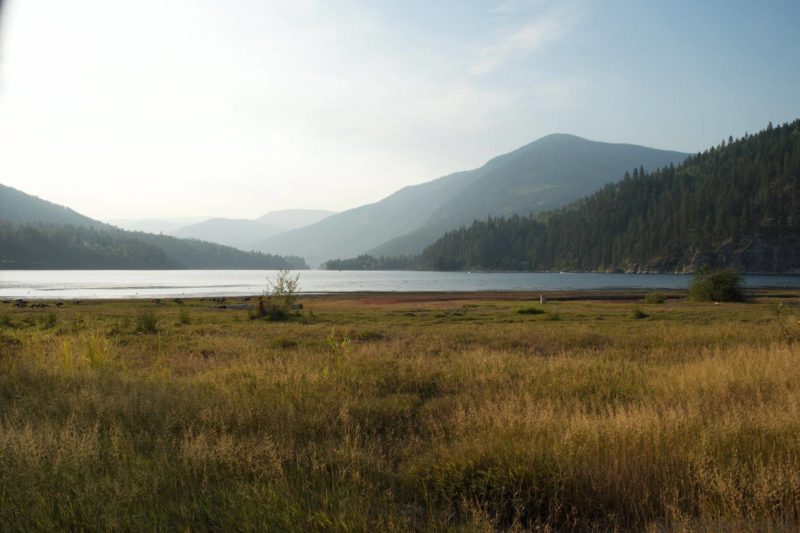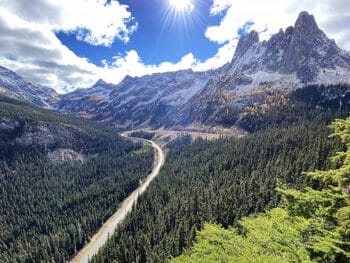Looking for an adventure off the beaten trail? Here are a few favourites near Nelson:
The Busk Estate
The strangest site in Kokanee Creek Provincial Park is an abandoned swimming pool, formerly on the estate of Charles W. Busk, from which the park was created.
Busk, a well-to-do English surveyor, came to Nelson in the late 1880s, where he laid out the lower Fairview neighbourhood and pre-empted land at Balfour. He also bought property further down the lake with plans to start an orchard and in 1901 hired Nelson architects Ewart and Carrie to design him a mansion.
The six-bedroom home overlooked the West Arm of Kootenay Lake and boasted an equal number of chimneys plus a spiral oak staircase. On the grounds were rock walls, a tennis court, stable, soccer field and the first private swimming pool in West Kootenay. Here Busk entertained for more than a decade until construction of a new highway threatened his paradise and he swapped the property for land at Deer Park.
Fast forward to 1955, when Kokanee Creek Park was established on land where Busk once ran a scout camp. The provincial government subsequently acquired the rest of the estate, including the now-derelict house. After someone tried to set it on fire, parks staff decided to finish the job themselves. But while the house is gone, some rock walls and a concrete staircase remain. The most impressive ruin is the oval-shaped concrete swimming pool, now covered with moss but still intact. It’s a short walk off Kokanee Glacier Road — but only if you know where to look.
Wilson Creek Falls
This waterfall drops 62 metres (207 feet) into a canyon in Goat Range Provincial Park near Rosebery. It’s well worth the short but steep hike. To get there, drive 5.3km north of New Denver on Highway 6, then turn right onto East Wilson Creek forest service road. It’s another 11.5 km along a gravel road until you reach a signed turnoff, then one kilometre over a very rough road to the trailhead.
The hike to the falls is a 2.2 km round trip.
Marblehead Quarry
Just north of Meadow Creek is the Marblehead quarry, established in the first decade of the 20th century. It provided building materials for impressive edifices locally and for the Mormon temple at Cardston, Alberta and Great West Life block in Winnipeg, among others. The quarry last operated in the 1930s but the giant cavity that remains is something to behold. Judging from all the graffiti, it’s also been a popular hangout for many decades.
Plans to re-establish the quarry as a business are on hold following the owner’s recent death. Marblehead survives as the name of the regional district transfer station and on the sign of Marblehead Automotive Service, which is an an old cookhouse.
The Diefenbunker
The basement of Nelson’s post office contains a Cold War secret: a bunker, built in 1963 to house local officials in the event of an atomic war or other crisis. It was one of 50 such facilities across Canada, nicknamed Diefenbunkers after Prime Minister John Diefenbaker, who authorized their construction. (Although technically, the name only applies to the largest one in Carp, Ont.)
The bunker was only ever used for civil defence exercises, and by the late 1960s was phased out and became storage for the post office. In 2013, the first public tour of the bunker was offered through Touchstones Nelson, which has since leased the space for artifact storage. A new permanent exhibit will open this year, examining the bunker’s history.
Rosemont pedestrian tunnel
When a new highway interchange was built at Nelson’s western approach in the early 1970s, a pedestrian tunnel was installed to connect lower Rosemont with Cottonwood Falls Park. But it’s easily overlooked. To access it from lower side, go to the end of Railway Street, opposite the Nelson District Rod and Gun Club and follow the sidewalk up the hill. Pop through the tunnel, under Highway 3A, and you’ll be spit out onto McHardy Street.
Cody
Sandon is one of BC’s best-known ghost towns. But travel a few more kilometres up the north side of the Carpenter Creek over a roughroad and you’ll arrive at much lesser-known Cody. A few old buildings still stand, along with the impressive ruins of the Noble Five concentrator. The town took its name after Cody Creek, in turn named for adventurer-prospector Henry Cody, also the namesake of the Cody Caves near Ainsworth.
BC’s provincial parks and many sites are closed during the COVID-19 pandemic, but to plan for future adventures here and throughout the West Coast, visit westcoasttraveller.com.











 Hiking, Biking, Hunting in Creston Valley
Hiking, Biking, Hunting in Creston Valley